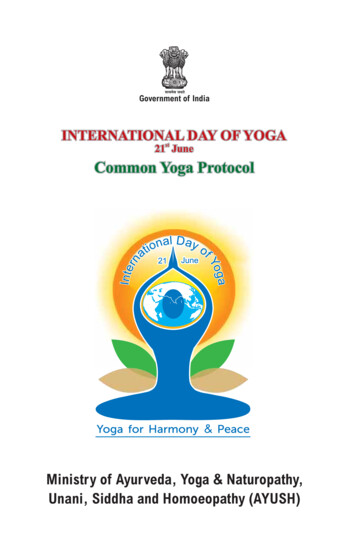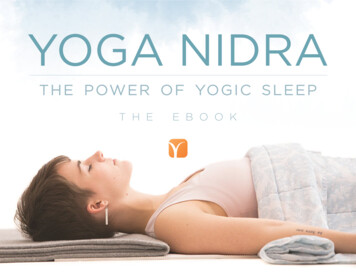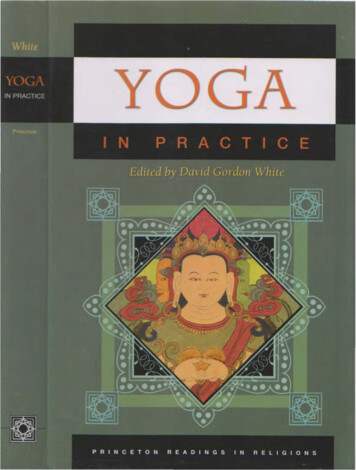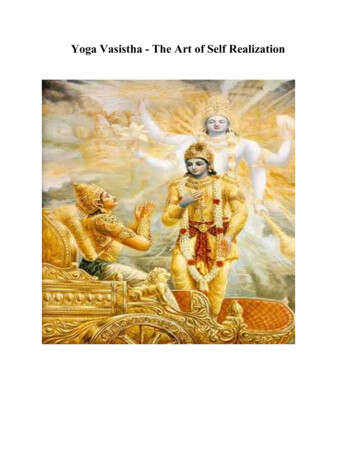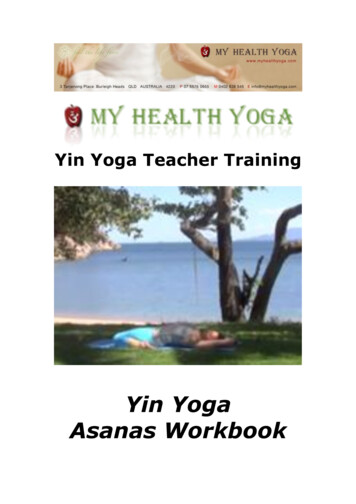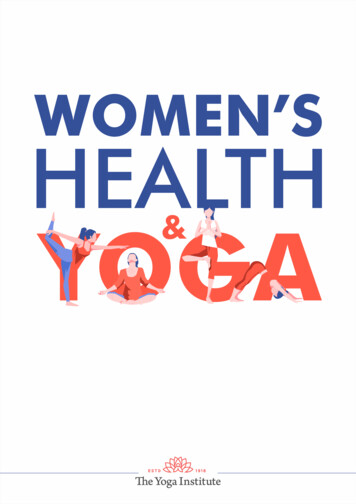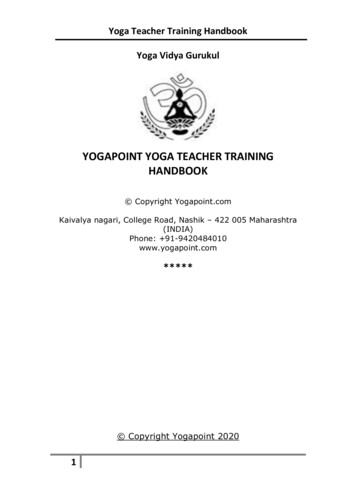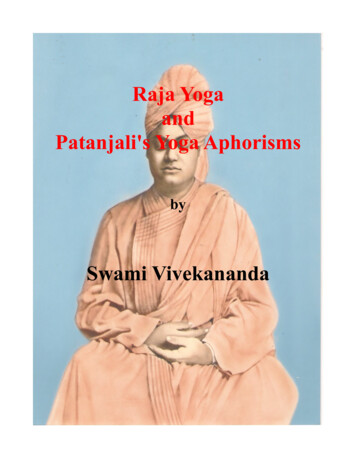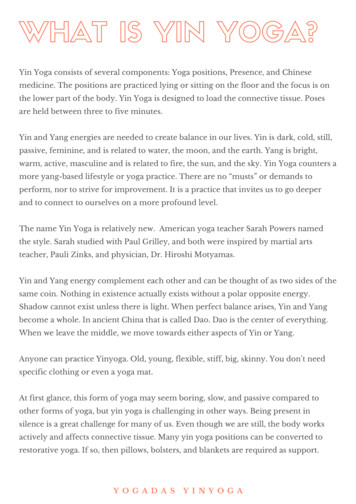
Transcription
WHAT IS YIN YOGA?Yin Yoga consists of several components: Yoga positions, Presence, and Chinesemedicine. The positions are practiced lying or sitting on the floor and the focus is onthe lower part of the body. Yin Yoga is designed to load the connective tissue. Posesare held between three to five minutes.Yin and Yang energies are needed to create balance in our lives. Yin is dark, cold, still,passive, feminine, and is related to water, the moon, and the earth. Yang is bright,warm, active, masculine and is related to fire, the sun, and the sky. Yin Yoga counters amore yang-based lifestyle or yoga practice. There are no “musts” or demands toperform, nor to strive for improvement. It is a practice that invites us to go deeperand to connect to ourselves on a more profound level.The name Yin Yoga is relatively new. American yoga teacher Sarah Powers namedthe style. Sarah studied with Paul Grilley, and both were inspired by martial artsteacher, Pauli Zinks, and physician, Dr. Hiroshi Motyamas.Yin and Yang energy complement each other and can be thought of as two sides of thesame coin. Nothing in existence actually exists without a polar opposite energy.Shadow cannot exist unless there is light. When perfect balance arises, Yin and Yangbecome a whole. In ancient China that is called Dao. Dao is the center of everything.When we leave the middle, we move towards either aspects of Yin or Yang.Anyone can practice Yinyoga. Old, young, flexible, stiff, big, skinny. You don’t needspecific clothing or even a yoga mat.At first glance, this form of yoga may seem boring, slow, and passive compared toother forms of yoga, but yin yoga is challenging in other ways. Being present insilence is a great challenge for many of us. Even though we are still, the body worksactively and affects connective tissue. Many yin yoga positions can be converted torestorative yoga. If so, then pillows, bolsters, and blankets are required as support.Y O G A D A SY I N Y O G A
WHAT IS YOGADA'SYINYOGA?Our style or approach to yin yoga came from the desire to be authentic in ourteaching. We are not afraid to say that our yoga style develops as we learn more.Research is constantly moving forward and therefore we view our yoga as an organic,living practice that must be allowed to progress - not stagnate.With expanded and in-depth knowledge in anatomy and movement theory, and witha passion and a yearning for a sustainable practice, the desire to integrate what welearned from CSV Yoga into our Yin Practice and Yogadas Yinyoga was created.After 10 years of teaching and practicing yoga, I was constantly meeting yogis withinjuries. They were all suffering from pain in their knees, shoulders, hands, and hipjoints. I was motivated to find out why. I found answers in certain asana positions andthe transitions into and out of them. More questions arose and with that my curiosityin anatomy grew. Shouldn’t yoga be a sustainable practice, and something that is goodand healing for the body?What many seem to forget or don’t know is that asanas we are aiming to perform werecreated for young boys in India about 120 years ago. Yoga poses were not at allintended for adults. Some positions are a pure anatomical disaster and several of theseare also found within the Yin Practice.During a training that I attended, I repeatedly questioned the instruction and anatomycues of many positions. I was surprised how, even experienced teachers, stubbornlystuck to the idea of trying to get into a prescribed shape. Of course, modifications andsupport were offered, but I kept asking myself: Is this the right way to go?The word modification (modifiering in Swedish) means that you can’t do the positionsthe right way, or the way it was intended. I don’t necessarily like this idea as it mayleave students feeling that there is a hierarchy within the poses. In yin yoga we do notstrive for a sense of accomplishment and nor do we aim to attain a certain shape. Weare present, here and now.Y O G A D A SY I N Y O G A
Therefore, I always think about what the purpose of the pose is, and how to achievethat purpose— whether it’s by stretching, releasing, or cultivating a state of mind— ina way that is gentle on the body where each pose is supported in a way that preventsjoint strain or over-stretching.Fundamentally, our intension is to create a practice that is anchored in breath, whereeach pose is supported in a way that prevents joint strain and over stretching tissues.Yin Yoga is a passive practice. We asked ourselves, “Should we stay longer in aposition where we have no support, where we are in full expression, over stretchingtissues, and risk overloading joints?” We looked at our own practice and came to theconclusion that a shift was necessary. We wanted to offer a Yin Yoga practice thataligns our more yang-based CSV Yoga practice.We are proud to present Yogada's Yinyoga. Our style is gentler, where positions arebetter supported and consist of soft-flowing movements, and where meditation andrest are considered as important as the poses themselves. Learn to guide yourstudents how to enter and exit poses with clarity. Breath is central and the focus lies oncreating a restful place where you can land, and reconnect with who you are.Meet yourself on the mat just the way you are today. No striving forward. Ease into arelaxed and flexible practice that you can adapt to your body and your needs. Allowyourself to just “be”. Welcome! Let's explore what Yin Yoga is, and together we willfind YOUR YOGA.Y O G A D A SY I N Y O G A
WHY SHOULD YOUPRACTICE YIN YOGA?1) When we practice Yin Yoga we get the opportunity to reconnect to and feelseveral aspects of our body.2) We are obliged to slow down.3) Yin Yoga teaches us acceptance and compassion.4) We cannot escape.5) Yin Yoga can help us become more resilient to stress.6) Yin Yoga can help your body become more mobile.7) Yin Yoga can help activate the parasympathetic (rest and digest) nervous system.8) In stillness there is room for meditation.9) Yin Yoga is balancing for us.10) Yin Yoga offers us a place where we can meet ourselves just as we are.Y O G A D A SY I N Y O G A
OUR PHILOSOPHYI created this style and approach to Yin Yoga with my co–teacher, Sofia Hillbom,from Sweden. We have trained over 100 teachers online and in-person. Now, wehave the opportunity to create a training in English to share with you all.Yogada's Yin Yoga is based on the key words CONSCIOUS PRESENCE. Thesewords, and several others, form the philosophy behind the teachings in our YinYoga classes that we are so passionate about.Our Yin Yoga is for everyone. But all positions are not for everyone at all times.Conscious Presence means listening to signals in your body and honoring whatyour body is communicating with you, today. Maybe you have injuries or pain inyour body or soul that need extra attention and care? Listening is key. We alwaysremind our students to listen and act accordingly.In order for you to lead your students in a safe way, we have created three steps inorder for you to guide your students into all positions.This is an inclusive space. Everyone is welcome to practice Yogada’s Yin Yogaregardless of background, religion, or ethnicity. We offer a safe place for everyoneto meet themselves just as they are.Y O G A D A SY I N Y O G A
3 STEPSGroundPhysical: How we meet the earth and how to set up the posePhilosophical: Listening inwards, Feeling safe and grounded. Knowing "I amenough", Being honest to yourself and others, Being humble and aware thateveryone we meet is on a personal journey and we might not see - or know thebattles they are facing.PresencePhysical: Presence in all aspects of the pose. As we move in to the pose we inhale(prepare) and exhale (start moving into the pose). Listening to the signals ourbody is giving us and acting on them.Philosophical: Practice being present in all situations and understanding that it isan ongoing work.SoftenPhysical: In our practice we want to try to soften and release both physical andemotional tension in our bodies and our mind. We use the breath as a tool andevery exhale is another oppertunity to release and soften a little bit more.Philosophical: Living life with "soft values" in a world where success orachievements is measured all the time can be difficult. We practice to let go ofothers expectations and not comparing our selfes to others. Being kind and notjudging others or yourself.Always enter each pose through these three steps. Take time to find themodifications and support you need to get comfortable. Exit every posemindfully and support your body as you exit.Y O G A D A SY I N Y O G A
HISTORY of YIN YOGAYinyoga was introduced to the Western world in the late 1970's by Paulie Zinks.Zinks is a martial arts expert and Taoist yoga teacher. Daoism or Taoism is one ofChina's three traditional religions / philosophies, along with Confucianism andBuddhism.Yin yoga is part of the Taoist tradition and offers ways to explore sensations inthe body, and to be present as sensation arises by holding positions for longerperiods of time.Two of the world's leading Yin Yoga teachers are, Paul Grilley and Sarah Powers(also students of Paulie Zinks). They have greatly influenced the style as we knowit today.Paulie Zink's approach includes the full spectrum of Taoist yoga (both yin andyang) and is, in itself, a complete practice. Meanwhile, the purpose of the yin yogaby Paul Grilley, and Sarah Powers, is to complement a more dynamic yogapractice or other physical exercise.Paul Grilley first saw Paulie Zink on television in 1988 when he showed the Taoistyoga techniques he used when he taught martial arts.He was very impressed and decided to study with Zink. Grilley, who had abackground in anatomy, moved to California and continued to study anatomywhile teaching yoga.In 1989, Grilley met Hiroshi Motoyama, a Japanese student and yogi who haddone extensive research in traditional Chinese medicine.Motoyama was very knowledgeable, especially regarding meridians and energyflows in the body. He linked Nadis, the life force that is said to be associated withthese energy paths, with the Chakra system.Y O G A D A SY I N Y O G A
Grilley began to integrate some of the Yin positions he learned from Zink andanatomy principles from studying with Motoyama, with his own Hatha yogastyle. He created yin sequences using the acupuncture foundations. Bernie Clark,also famous in the yin yoga world, says that the relationships Grilley makesbetween Taoist yoga and the meridian system is what contributed to more peoplebeing able to understand, and feel, the benefits of this practice where body, soul,and mind align.One of Grilley's students, Sarah Powers, also a yoga teacher in her own right,began teaching yin yoga inspired by Grilley. She incorporated Buddhistpsychology but with even more of a focus on the meridian system. Grilley andPowers decided to call the yoga they taught, Yin Yoga, in order to distinguish itfrom Paulie Zink's Taoist yoga. Later, Zink also started to call his practice YinYoga. Over the next 10 years they gave classes, seminars, and trainingsthroughout the United States and Europe and spread the teachings of Yin Yoga.Paulie Zink's Yin Yoga contains yin and yang positions and additional movementsbetween poses. This is designed to explore the physical and energetic aspects, aswell as the mindfulness that is required to “hold” a position.The style that Paul Grilley and Sarah Powers offer consists of a series of passivepositions on the floor that mostly include the lower body (hips, pelvis, innerthighs, low spine). The emphasis is on the importance of mixing their yin practicewith yang practices but not necessarily mixing yin and yang styles.During longer holds, the teacher usually does "dharma talk," which are informaldiscussion based on the teacher's perspective. The subject matter of these talksmay range from traditional Buddhist stories, poems, songs, to the teacher’spersonal ideas about life. Often an anatomical explanation is incorporated intothe instruction when guiding a student into a position. It is common to mentionthe meridians associated with each pose.Paulie Zink says that within Yin yoga there lies, "a means to open the heart andinvoke the self.” Sarah Powers says, "Yin yoga is an opportunity to practice andcultivate inner stillness.”Y O G A D A SY I N Y O G A
THE BREATHThere is no specific type of breathing in Yin Yoga. We try to keep the breath soft andnatural. That could mean longer or shorter inhales or exhales at any time.Most importantly, we don’t have to force our breath into something that feels unnaturalor restrained.Many of us have lost touch with our natural breath. When we feel stressed or pressured,our breathing often gets stuck high up in the chest and this occurs without ourawareness.A natural, soothing breath is a breath that is connected to the belly. When you inhale, theabdomen and lower part of the chest rise and when you exhale it slowly sinks back in toneutral. This is a very good exercise, preferably in the beginning of class. Just instruct thestudents to follow their breath by allowing the belly to remain soft and relaxed.Exhalation is a fantastic tool for releasing tension. Every exhale leads to deeperrelaxation. Encourage your students to try to let go, little by little, with every exhale.Exhalation helps us surrender both physically and mentally. A soft sigh with an openmouth can be freeing for body and soul.Calm, soft, deep breathing also affects the nervous system. In simple terms, the body's"Rest and Digest" response or "parasympathetic nervous system", is affected by a relaxedbreathing pattern. Shallow, rapid breathing can trigger the sympathetic nervous systeminto "Fight or Flight” response.The focus on breath, unhurried movement, and stillness of Yin Yoga invites you to stopand feel. These are powerful tools for stress management. The more we practice a softand soothing approach to breath, the easier it is to remember that belly breathing helpsinduce relaxation when we need to gather new strength. And then the easier it is to applyin everyday life.There are several different types of breathing exercises that can be incorporated intoclasses. Remember that these are exercises, so speak about the benefits and offerguidance without being too strict and controlling. Promote and encourage a deep, freebreath.Y O G A D A SY I N Y O G A
5) Yin Yoga can help us become more resilient to stress. 6) Yin Yoga can help your body become more mobile. 7) Yin Yoga can help activate the parasympathetic (rest and digest) nervous system. 8) In stillness there is room for meditation. 9) Yin Yoga is balancing for us. 10) Yin Yoga offe
